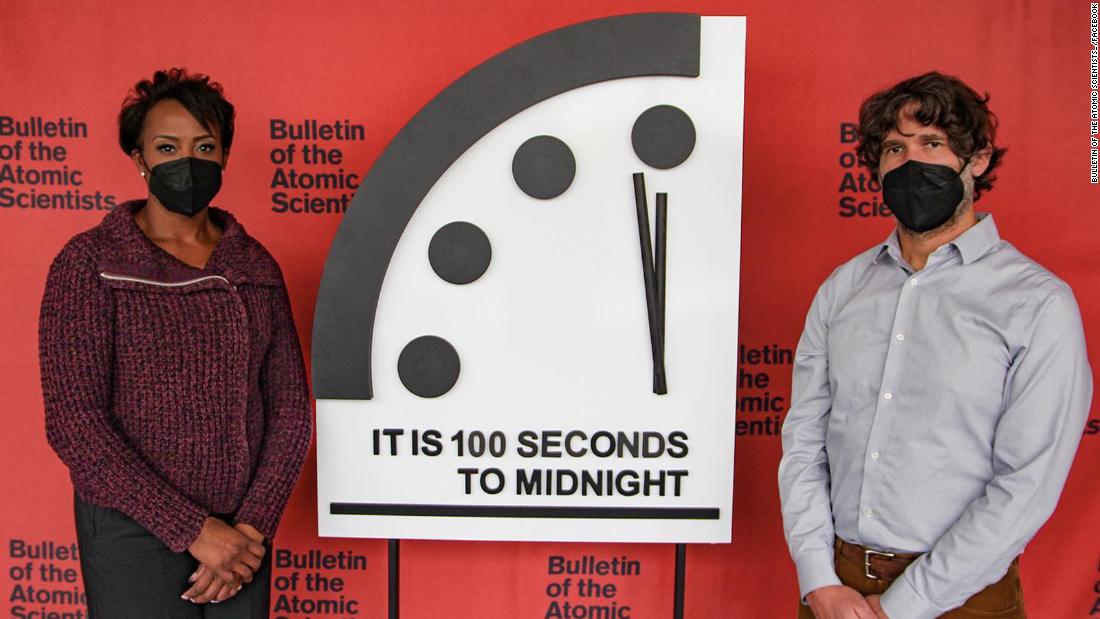This country would be better prepared for a global collapse 0:43
(CNN) --
The Doomsday Clock, also known as the "Doomsday Clock," has been ticking for exactly 75 years.
But it's not just any watch.
Try to gauge how close humanity is to destroying the world.
In 2022, the clock was set at 100 seconds to midnight;
the same time since 2020.
The clock is not designed to categorically measure existential threats, but rather to spark conversations about difficult scientific topics like climate change, according to the Bulletin of Atomic Scientists, which created the clock in 1947.
"One hundred seconds to midnight reflects the Board's judgment that we are trapped in a dangerous moment, which brings neither stability nor security. The positive developments of 2021 failed to offset the long-term negative trends," Sharon Squassoni said then, co-chair of the Bulletin's Science and Safety Council, which sets the clock time.
Squasson is also a Research Professor at George Washington University's Institute for International Science and Technology Policy.
The Clock of the Apocalypse or Doomsday Clock stood at 100 seconds from midnight in 2022, the same time since 2020.
What is the Doomsday Clock?
The Bulletin of Atomic Scientists was a group of atomic scientists who worked on the Manhattan Project, the code name for the development of the atomic bomb during World War II.
advertising
China could stockpile 1,500 nuclear warheads by 2035, Pentagon report reveals
Originally, it was intended to measure nuclear threats, but in 2007 the Bulletin made the decision to include climate change in its calculations.
Over the past three-quarters of a century, the time on the clock has changed, depending on how close scientists believe the human race is to total destruction.
Some years the weather changes, and others not.
The Doomsday Clock is set each year by experts on the Bulletin's Science and Safety Council in consultation with its Board of Sponsors, which includes 11 Nobel laureates.
Although the clock has been an effective wake-up call in reminding people of the cascading crises facing the planet, some have questioned the usefulness of the 75-year-old clock.
Lawrence Krauss, a former member of the Bulletin's Board of Sponsors, said that while time has passed since the clock began ticking, it has been difficult to take its results seriously, as it has come perilously close to the end of time in recent decades. civilization.
As a theoretical physicist, Krauss has been concerned with how the clock is evaluated and determined today.
Every year, he said, when the clock approaches midnight alarmingly, scientists would have to measure how much available "space" is left before deciding how much further the clock should move.
"Now the clock moves in seconds, before it was minutes," Krauss told CNN.
"It is clear that it is not a quantitative scientific evaluation, but rather a qualitative one. What was always important is the movement of the clock, not its absolute value."
What happens if the clock reaches midnight?
The clock never struck midnight, and Rachel Bronson, the Bulletin's president and CEO, hopes it never will.
Global Challenges: how to prevent a nuclear apocalypse
"When the clock strikes midnight, it means that some kind of nuclear exchange or catastrophic climate change has taken place that has wiped out humanity," he says.
"So we don't want to ever get there and we won't know when we do."
How accurate is the watch?
Clock Hour is not intended to measure threats, but rather to spark conversations and foster public engagement on scientific issues such as climate change and nuclear disarmament.
If the watch is capable of doing that, then Bronson considers it a success.
When a new time is set on the clock, people listen, he said.
In 2021, during the COP26 climate talks in Glasgow, then UK Prime Minister Boris Johnson cited the Doomsday Clock when discussing the climate crisis facing the world, Bronson noted.
Bronson said he hopes people will discuss whether they agree with his decision and have fruitful conversations about what the driving forces for change are.
COP 27: have these meetings against climate change been of any use?
It is still possible to turn back the clock with bold and concrete actions.
In fact, the hands have moved away before midnight, reaching 17 minutes before midnight in 1991, when the administration of President George HW Bush signed the Strategic Arms Reduction Treaty with the Soviet Union.
In 2016, the clock was three minutes before midnight as a result of the Iran nuclear deal and the Paris climate accord.
What can an individual do to turn back time on the clock?
Don't underestimate the power of discussing these important issues with your colleagues, Bronson said.
"You may not feel it because you're not doing anything, but we know that public engagement moves (a) leader to do things," he said.
What can we do about climate change?
1:42
When it comes to climate change, look at your daily habits and see if there are small changes you can make in your life, like walking more often instead of driving and what you use to keep your home warm, Bronson explained.
doomsdayClock





/cloudfront-eu-central-1.images.arcpublishing.com/prisa/4XEFCJJ6OBGEVN2626XOLJD47Y.jpg)


